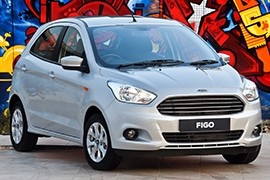The American carmaker introduced the second generation of the Figo for the Indian market in 2015 based on the same platform as the European Ford Ka.
While the first generation of the Figo sat on a Fiesta platform, the second generation used a Ka+ base. It might seem a downgrade, but it wasn’t. The car even sported a longer wheelbase and used similar technical solutions but enhanced. Strangely, Ford chose to launch the three-box version of the Figo (Figo Aspire) first, and then the hatchback came later. Its new bodywork included high-strength steel and improved shock-absorbing areas.
On the outside, the former boxy shape of Figo’s first generation was gone. It was the time for rounded shapes and new, angled, and angular-shaped headlights. Its “aston-esque” grille featured four horizontal chromed lines. On its sides, the carmaker installed a set of sculptured doors. It adopted the same solution for the European Ka+, which was available in selected countries.
The interior was not among the best in its class, but it offered enough comfort and features for daily use. Its instrument panel sported a large speedometer in the middle flanked by a tachometer on the left and a fuel level on its right side. Strangely, there wasn’t any coolant-temperature gauge. Its role was taken by a simple blue and red indicator light. The materials used on the dash panel, door cards, and center stack were not high-end, but they were good enough for the car’s price.
Ford offered the small vehicle with a choice of three engines paired as standard to a five-speed manual. The Figo S provided a 1.5-liter 111 hp powerplant paired as an option with a six-speed automatic for the top-spec version. A turbo-diesel unit was available as well.

























































